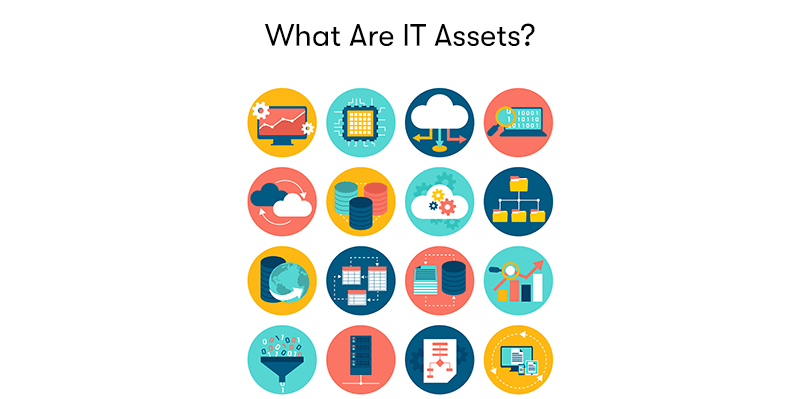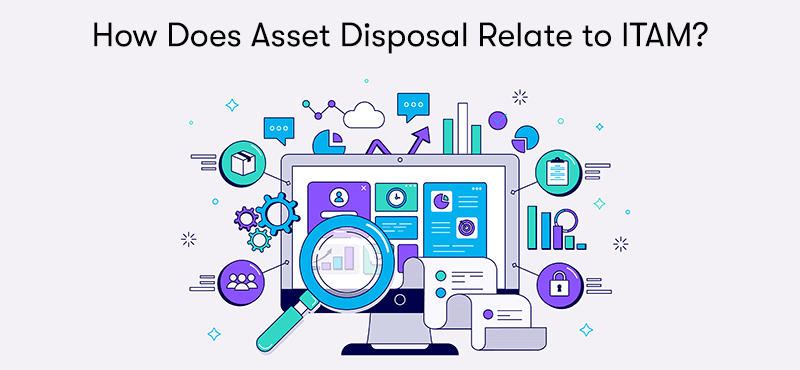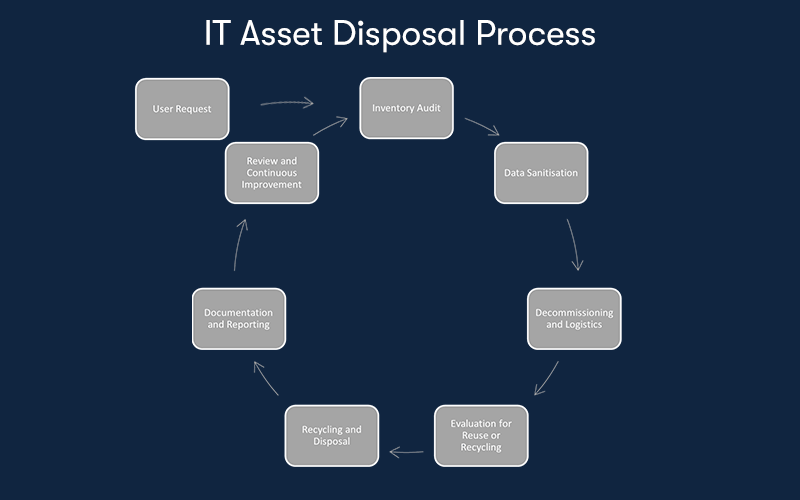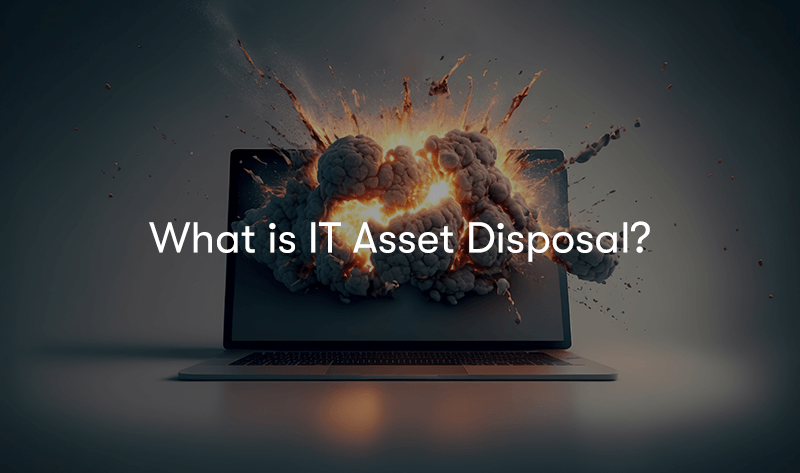What is IT Asset Disposal
Welcome to our in-depth exploration of IT Asset Disposal (ITAD), a critical process in the lifecycle management of business technology. In this digital era, where technology rapidly evolves, ITAD has become more than just a mere operational task; it's a strategic necessity. This process involves the safe and responsible disposal of outdated or unwanted electronic equipment, ranging from computers and servers to smartphones and printers. But ITAD is not just about disposing of old hardware; it's a multifaceted approach that includes data security, compliance with legal standards, and environmental responsibility.
As we delve into the world of ITAD, we'll uncover its importance, processes, and the pivotal role it plays in safeguarding data, adhering to regulatory requirements, and promoting sustainable practices in the ever-changing landscape of information technology.
What is IT Asset Disposal?
IT Asset Disposal is a critical process in managing business technology resources. It involves the safe, efficient, and environmentally responsible disposal of obsolete or unwanted electronic equipment, such as computers, servers, smartphones, and printers. ITAD is not just about physical disposal; it encompasses a range of activities, from the logistics of collecting old equipment to ensuring data security and compliance with legal and environmental regulations.
The first step in ITAD is inventory management. This involves identifying and cataloguing IT assets that are no longer needed or are reaching the end of their lifecycle. This process helps organisations understand what assets they have, their condition, and their residual value.
Data security is a crucial aspect of ITAD. Before disposing of any IT equipment, it is essential to erase all sensitive data permanently. This can be achieved through data wiping, degaussing, or physical destruction of the storage media. This step is vital to protect against data breaches and comply with regulations like the General Data Protection Regulation (GDPR) and the Health Insurance Portability and Accountability Act (HIPAA).
After data security, the physical disposal of the IT assets takes place. This can include recycling, reselling, or donating the equipment. Recycling is a preferred method as it helps reduce electronic waste and its environmental impact. Companies specialising in ITAD often have processes to extract and recycle valuable materials from electronic waste safely.
Finally, ITAD also involves compliance with various environmental and data protection laws. Proper documentation and certification from ITAD service providers ensure that the disposal process adheres to legal requirements and organisational policies. This compliance is critical to avoid fines and maintain the organisation's reputation.
Overall, IT Asset Disposal is a comprehensive process that addresses the entire lifecycle of IT equipment, ensuring data security, legal compliance, and environmental responsibility.
What Are IT Assets?

IT assets are any information technology equipment, systems, or related resources an organisation uses to manage its information and business processes. These assets play a crucial role in modern organisations' operational effectiveness and efficiency. IT assets can be broadly categorised into:
Hardware
This includes physical devices such as computers (laptops, desktops), servers, networking equipment (routers, switches), printers, and other peripherals. It also encompasses data centre infrastructure and mobile devices like smartphones and tablets.
Software
Software assets include operating systems, application software, databases, and other programs used for business operations. This category also covers licenses and subscriptions for software products.
Data
Although often overlooked, data is a crucial IT asset. It includes all the information generated, processed, stored, and used by an organisation, such as customer data, financial data, research data, and intellectual property.
Networks
This refers to the communication infrastructure, including the physical network (cabling and wireless access points) and network resources (bandwidth and virtual networks).
Cloud Resources
With the rise of cloud computing, IT assets include cloud-based services and infrastructure, like storage space, processing power, and various software as a Service (SaaS) offerings.
IT Personnel
The skills and knowledge of IT staff are considered assets. This includes system administrators, network engineers, software developers, and IT managers.
Documentation and Procedures
Operational manuals, IT policies, user guides, and other documentation related to IT systems are also valuable assets.
Properly managing these assets is essential for supporting the organisation's goals effectively and efficiently. IT Asset Management (ITAM) is the practice of managing these assets throughout their lifecycle to maximise value and control costs while mitigating risks associated with IT.
Why is Disposal of IT Assets Important for Your Company?

Disposal of IT assets is crucial for any company for several reasons:
Data Security
One of the primary concerns during IT asset disposal is the security of sensitive data. Old computers, servers, and storage devices contain confidential information such as customer details, business records, and intellectual property. Proper disposal ensures that this data is erased or destroyed, preventing potential data breaches that could lead to legal issues, financial losses, and damage to the company's reputation.
Compliance with Regulations
Various laws and regulations, like the General Data Protection Regulation (GDPR) in the EU or the Health Insurance Portability and Accountability Act (HIPAA) in the USA, mandate strict handling and disposal of electronic data. Non-compliance can result in hefty fines and legal repercussions. Ensuring proper disposal of IT assets helps in staying compliant with these regulations.
Environmental Responsibility
Electronic waste (e-waste) is a significant environmental issue due to toxic substances found in electronic devices, such as lead, mercury, and cadmium. Responsible disposal through recycling or certified e-waste management processes minimises environmental impact and promotes sustainability, aligning with corporate social responsibility goals.
Cost Management
Efficient IT asset disposal can also have financial benefits. Companies can recover some value from these assets by selling or recycling obsolete equipment. Moreover, efficient disposal and upgrade cycles ensure the organisation is not spending resources maintaining outdated technology.
Resource Optimisation
Regular disposal and updating of IT assets ensure that the company's technology infrastructure remains modern, efficient, and capable of meeting current operational needs. This leads to improved productivity and can give a competitive edge.
Space Management
Physically disposing of obsolete equipment frees up valuable office or storage space, leading to a more organised and efficient work environment.
Brand Image and Trust
Demonstrating a commitment to data security and environmental responsibility can enhance a company's brand image and trust among customers and stakeholders.
In summary, the disposal of IT assets is essential for maintaining data security, complying with legal requirements, protecting the environment, managing costs and resources efficiently, and enhancing the company's overall image and trustworthiness.
How Does Asset Disposal Relate to ITAM?

Asset disposal is a critical component of ITAM as it relates to the end-of-life stage of an asset's lifecycle. ITAM is a comprehensive strategy for managing an organisation's IT resources throughout their lifecycle, from acquisition to disposal. Here's how asset disposal relates to ITAM:
Lifecycle Management
ITAM involves managing the entire lifecycle of IT assets, including planning, acquiring, deploying, maintaining, and eventually disposing of them. Asset disposal is the final phase in this lifecycle. Effective ITAM ensures that assets are not only well-utilised throughout their life but also responsibly and securely disposed of at the end of their lifecycle.
Inventory Control and Record Keeping
ITAM requires maintaining accurate records of all IT assets, including those due for disposal. This inventory management ensures that all assets are accounted for, essential for operational efficiency and compliance with regulatory requirements. When assets are disposed of, ITAM processes ensure that these changes are reflected in inventory records, maintaining the accuracy of the asset database.
Risk Management
Proper disposal of IT assets as part of ITAM helps mitigate data security risks and environmental compliance risks. Secure data destruction or wiping as part of the disposal process protects against data breaches. Additionally, environmentally responsible disposal practices reduce the risk of non-compliance with e-waste regulations.
Cost Optimisation
ITAM focuses on optimising the value obtained from IT assets. This includes ensuring that assets are not disposed of prematurely or kept longer than necessary, which can incur unnecessary costs. ITAM strategies can identify when assets should be retired and disposed of, optimising the return on investment and generating revenue through resale or recycling.
Compliance and Auditing
Compliance with various regulatory requirements is a significant aspect of ITAM. Asset disposal processes must adhere to legal standards for data privacy, environmental regulations, and financial reporting. ITAM provides the framework to ensure that disposal activities are compliant and can be audited.
Strategic Planning
In the context of ITAM, asset disposal data helps in strategic planning for future asset acquisitions and lifecycle management. Understanding assets' lifespan and maintenance costs informs better purchasing decisions and technology strategies.
In summary, asset disposal is an integral part of ITAM, ensuring that IT assets are responsibly and efficiently managed through the end of their life. This process supports risk management, cost optimisation, compliance, strategic planning, and maintaining accurate inventory records, all essential components of effective IT Asset Management.
What is the Process of IT Asset Disposal?

IT Asset Disposal typically involves several key steps to ensure that the assets are disposed of securely, efficiently, and in compliance with legal and environmental standards. Here is an overview of the process:
Inventory Audit
The first step involves conducting a thorough inventory audit. This means identifying and cataloguing all IT assets that are earmarked for disposal. This audit helps understand what assets are being disposed of, their condition, and potential associated risks (like stored sensitive data).
Data Sanitisation
This is a crucial step in the ITAD process. It involves securely wiping or destroying data stored on hard drives, SSDs, and mobile devices. Data sanitisation methods can include software-based data wiping, degaussing (using a high-powered magnet to destroy data on magnetic storage), or physical destruction. This step ensures compliance with data protection laws and prevents data breaches.
Decommissioning and Logistics
Decommissioning involves physically removing the IT assets from their operational environment. This can include uninstalling software, disconnecting hardware, and preparing the assets for transportation. The logistics phase involves safely and securely transporting the assets from the company's premises to the disposal facility or a new location (if being resold or donated).
Evaluation for Reuse or Recycling
Once the assets arrive at a disposal facility, they are evaluated for their potential for reuse, resale, or recycling. Functional and repairable items might be refurbished and sold or donated. Assets that cannot be reused are sent for recycling.
Recycling and Disposal
IT assets are dismantled in the recycling phase, and their components are sorted. Materials like metals, plastics, and glass are recovered and sent to specialised recyclers for processing. This step is critical for minimising environmental impact and ensuring compliance with e-waste disposal regulations.
Documentation and Reporting
Proper documentation is maintained throughout the ITAD process. This includes records of data sanitisation, certificates of recycling, and transfer of ownership documents (if applicable). This documentation is essential for audit purposes and to demonstrate compliance with various regulations.
Final Review and Continuous Improvement
After the disposal process, a final review is typically conducted. This can involve assessing the effectiveness of the ITAD process, identifying any areas for improvement, and updating policies and procedures as needed.
This structured approach to IT asset disposal helps organisations manage data security and compliance risks, maximise the residual value of their IT assets, and ensure environmentally responsible disposal practices.
Are There Services That Will Dispose of IT Assets?
Yes, there are specialised services that handle the disposal of IT assets. These services, often referred to as IT Asset Disposition providers offer a range of solutions to manage the end-of-life of IT equipment. Here's an overview of what these services typically offer:
Data Destruction and Sanitisation
ITAD providers ensure that all data stored on devices is completely and securely erased. They use various methods such as software wiping, degaussing, or physical destruction to eliminate the risk of data breaches. They often provide certificates of data destruction for compliance and auditing purposes.
Environmentally Responsible Recycling
These services comply with environmental regulations and ensure that e-waste is disposed of in an environmentally friendly manner. They often have e-Stewards or R2 (Responsible Recycling) certifications, indicating adherence to best practices in e-waste recycling.
Asset Remarketing and Resale
ITAD providers assess the value of IT assets and may offer resale or remarketing services. This can help businesses recover some residual value from outdated or excess equipment.
Asset Tracking and Reporting
They provide detailed reporting and tracking of the entire disposal process. This documentation is crucial for regulatory compliance and can assist in internal asset management and auditing.
Logistics and Transportation
ITAD services often include the logistics of collecting and transporting IT assets from the business premises to the disposal facility. They ensure that this is done securely and efficiently.
Regulatory Compliance
These providers are knowledgeable about various regulations related to data privacy and environmental standards. They help businesses comply with laws like GDPR, HIPAA, and various e-waste disposal regulations.
Donation Programs
Some ITAD services also facilitate the donation of usable equipment to non-profit organisations, schools, or other entities, often as part of a corporate social responsibility initiative.
When choosing an ITAD provider, businesses need to consider factors such as the provider's certifications, compliance with relevant laws and regulations, data security measures, environmental policies, and the overall cost of the service. Proper vetting ensures that the chosen service aligns with the company's data security, legal compliance, and environmental responsibility goals.
Final Notes on IT Asset Disposal
In conclusion, the disposal of IT assets is a critical aspect of modern business operations. It encompasses IT Asset Management, ensuring security, compliance, and efficiency in handling end-of-life technology. The process involves meticulous steps from inventory audit to data sanitisation and from environmentally responsible recycling to detailed documentation.
The significance of IT asset disposal lies in protecting sensitive data, adhering to legal requirements, and promoting environmental sustainability. For businesses looking for streamlined handling of this complex process, specialised ITAD providers offer comprehensive services, including secure data destruction, asset remarketing, and regulatory compliance.
As we navigate the digital age, the responsible and strategic disposal of IT assets is a crucial practice for operational integrity, risk management, and environmental stewardship.


